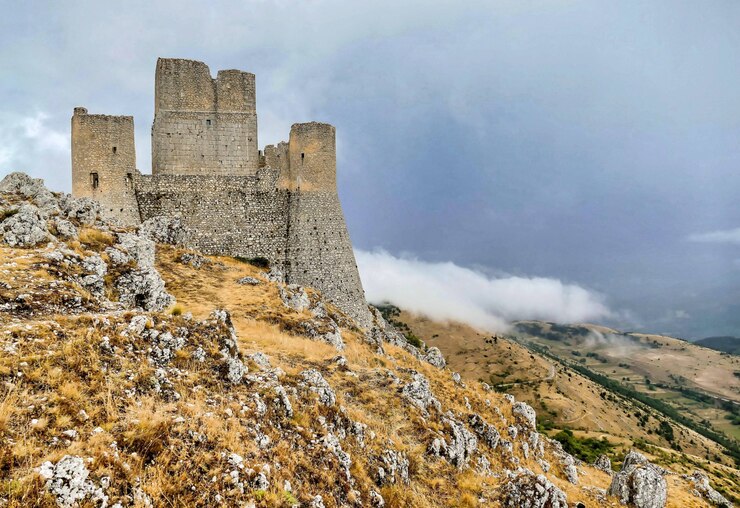Introduction
Perched high in the Apennine Mountains of Italy, Rocca Calascio is a medieval fortress that captures the imagination with its breathtaking views and historical significance. This article explores the history, architectural features, and cultural importance of Rocca Calascio, a hidden gem in the Abruzzo region.
Historical Background
- Early Origins: The origins of Rocca Calascio date back to the 10th century. Initially constructed as a simple watchtower, it was strategically positioned to oversee the surrounding valleys and protect the region from invaders.
- Medieval Expansion: By the 13th century, Rocca Calascio had evolved into a formidable fortress. The structure was expanded to include more robust defensive walls and additional towers. Reflecting the need for greater security during the turbulent medieval period.
- Strategic Importance: Situated at an altitude of 1,460 meters (4,790 feet), Rocca Calascio served as a vital lookout point. Its high vantage allowed for early detection of approaching enemie. And communication with other fortresses in the region through signal fires.
Architectural Features
- Fortress Design: Rocca Calascio is renowned for its austere yet imposing design. The fortress is characterized by its quadrilateral layout, with four corner towers connected by thick defensive walls. The main tower, or keep, stands at the center, offering panoramic views of the surrounding landscape.
- Construction Materials: The fortress was built using local limestone. Which not only provided strength and durability but also helped the structure blend seamlessly with its natural surroundings.
- Church of Santa Maria della Pietà: Adjacent to the fortress is the octagonal Church of Santa Maria della Pietà, constructed in the 16th century. This small, picturesque church adds to the historical and architectural allure of Rocca Calascio.
Cultural and Historical Significance
- Preservation of History: Rocca Calascio is a testament to the medieval history of Italy. It offers a glimpse into the defensive strategies and architectural techniques of the time, preserving a crucial part of the region’s heritage.
- Cinematic Fame: The fortress gained international recognition after being featured in several films, most notably “Ladyhawke” (1985) and “The Name of the Rose” (1986). These films showcased the dramatic and otherworldly ambiance of Rocca Calascio, drawing attention to its beauty and historical value.
- Tourism and Accessibility: Today, Rocca Calascio is a popular destination for tourists, hikers, and history enthusiasts. The fortress is accessible via a scenic hike, which allows visitors to fully appreciate the natural beauty of the Apennine Mountains and the ingenuity of medieval architecture.
Visiting Rocca Calascio
- Best Time to Visit: The best time to visit Rocca Calasci’o is during the late spring, summer. And early autumn months when the weather is mild and the hiking trails are most accessible.
- Nearby Attractions: Visitors to Rocca Calasci’o can also explore nearby attractions such as the town of Santo Stefano di Sessanio, known for its well-preserved medieval architecture. And the Gran Sasso National Park, which offers stunning landscapes and outdoor activities.
- Local Culture: The Abruzzo region is rich in cultural traditions, cuisine, and hospitality. Visitors can enjoy local specialties such as arrosticini (skewered lamb) and pecorino cheess. While experiencing the warmth and charm of the local communities.
Conclusion
Rocca Calascio stands as a magnificent symbol of Italy’s medieval past and architectural prowess. Its lofty perch, historical significance, and cinematic fame make it a captivating destination for anyone interested in history, architecture, or simply breathtaking vistas. A visit to Rocca Calasci’o is a journey back in time. Offering a unique opportunity to connect with the rich heritage and natural beauty of the Abruzzo region.







